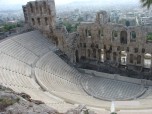The Panathenaic Stadium is an athletic arena in the Greek capital, Athens. Dating back more than 2,000 years, it is the oldest stadium in the world still used for sporting events. Its most famous role in modern times was as the main stadium used in the 1896 Olympic Games, the first of the modern era. Notably, Harvard Stadium in Cambridge, Massachusetts is modeled on its design.
History of the Stadium
The stadium is named for the Panathenaic Games, which were first held in the sixth century BC. Around two hundred years later, its original wooden seats were replaced with white marble. It remains the only large sporting arena to be constructed of this material. By the time the stadium was enlarged in the second century AD by Herodes Atticus, it had seating space for around 50,000 spectators.
After the collapse of classical civilization, the stadium gradually decayed until it was rediscovered in the 19th century. Evangelis Zappas, one of the pioneers of the modern Olympic movement, paid for games to be held at the stadium in the 1870s, although it was not until 1895 that it was fully refurbished. A statue of George Averoff, the philanthropist and businessman who provided funds for the stadium’s completion, stands at its entrance.
Location and Design
The stadium lies in Pangrati, a district of central Athens close to the National Gardens. The Ilissos River once flowed close to the entrance to the stadium, and in earlier times the area was highly susceptible to flooding. This changed when the river was covered by new development in the 1950s. The stadium forms part of a notable sporting district in the city, with a number of other facilities being close by. These include swimming pools, tennis clubs, and other athletics tracks.
The white marble used for the building of the stadium originates from Mount Penteli. The arena’s size and dimensions closely conform to the usual ancient Greek model, with tight hairpin bends rather than the more open curves seen on a modern running track. At its peak, it is believed that as many as 80,000 spectators were able to squeeze into the marble steps which surround the track. The stadium’s modern capacity is around 45,000.
Notable Events
As well as being the centerpiece of the 1896 Olympic Games, the Panathenaic Stadium was also employed for the 2004 Olympics. The design of its running track made it unsuitable for most track and field events, although the marathon finished there; instead, the venue was used for archery. Mostly, however, the stadium’s sports-related role in recent years has been confined to hosting ceremonies and receptions. The victorious Greek soccer team from the 2004 European Championships was honored at the stadium.
A number of non-sporting events have also been hosted at the stadium. Its relatively large capacity has made it a popular venue for concerts, with acts such as Tina Turner, Bob Dylan, and REM among those to have appeared there. A number of Greek artists have also featured at the stadium, including Sakis Rouvas, who attracted a record crowd of 50,000 for his concert in aid of the environment in 2009.





















